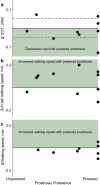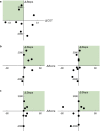The influence of powered prostheses on user perspectives, metabolics, and activity: a randomized crossover trial
- PMID: 33726802
- PMCID: PMC7962267
- DOI: 10.1186/s12984-021-00842-2
The influence of powered prostheses on user perspectives, metabolics, and activity: a randomized crossover trial
Abstract
Background: Powered prosthetic ankles provide battery-powered mechanical push-off, with the aim of reducing the metabolic demands of walking for people with transtibial amputations. The efficacy of powered ankles has been shown in active, high functioning individuals with transtibial amputation, but is less clear in other populations. Additionally, it is unclear how use of a powered prosthesis influences everyday physical activity and mobility.
Methods: Individuals with unilateral transtibial amputations participated in a randomized clinical trial comparing their prescribed, unpowered prosthesis and the BiOM powered prosthesis. Participants' metabolic costs and self-selected walking speeds were measured in the laboratory and daily step count, daily steps away from home, and walking speed were measured over two weeks of at-home prosthesis use. Participants also rated their perception of mobility and quality of life and provided free-form feedback. Dependent measures were compared between prostheses and the relationships between metabolic cost, perception of mobility, and characteristics of walking in daily life were explored using Pearson's correlations.
Results: Twelve people were randomly allocated to the powered prosthesis first (n = 7) or unpowered prosthesis first (n = 5) and ten completed the full study. There were no differences in metabolic costs (p = 0.585), daily step count (p = 0.995), walking speed in-lab (p = 0.145) and in daily life (p = 0.226), or perception of mobility between prostheses (p ≥ 0.058). Changes varied across participants, however. There were several medium-sized effects for device comparisons. With the powered prosthesis, participants had increased self-reported ambulation (g = 0.682) and decreased frustration (g = 0.506).
Conclusions: There were no universal benefits of the powered prosthesis on function in the lab or home environment. However, the effects were subject-specific, with some reporting preference for power and improved mobility, and some increasing their activity and decreasing their metabolic effort. Additionally, self-reported preferences did not often correlate with objective measures of function. This highlights the need for future clinical research to include both perception and objective measures to better inform prosthetic prescription.
Trial registration: https://clinicaltrials.gov , #NCT02828982. Registered 12 July 2016, https://clinicaltrials.gov/ct2/show/NCT02828982.
Keywords: Accelerometer; Inertial measurement unit; Metabolic cost; Microprocessor ankle; Preference; Step count; Transtibial amputation; Walking speed.
Conflict of interest statement
The authors declare that they have no competing interests.
Figures






Similar articles
-
Step-to-step transition work during level and inclined walking using passive and powered ankle-foot prostheses.Prosthet Orthot Int. 2016 Jun;40(3):311-9. doi: 10.1177/0309364614564021. Epub 2015 Jan 27. Prosthet Orthot Int. 2016. PMID: 25628378
-
Does use of a powered ankle-foot prosthesis restore whole-body angular momentum during walking at different speeds?Clin Orthop Relat Res. 2014 Oct;472(10):3044-54. doi: 10.1007/s11999-014-3647-1. Clin Orthop Relat Res. 2014. PMID: 24781926 Free PMC article.
-
A controlled clinical trial of a clinically-tuned powered ankle prosthesis in people with transtibial amputation.Clin Rehabil. 2018 Mar;32(3):319-329. doi: 10.1177/0269215517723054. Epub 2017 Jul 27. Clin Rehabil. 2018. PMID: 28750586 Clinical Trial.
-
A systematic investigation of sensorimotor mechanisms with intelligent prostheses in patients with ankle amputation while walking.J Mech Behav Biomed Mater. 2024 Mar;151:106357. doi: 10.1016/j.jmbbm.2023.106357. Epub 2023 Dec 30. J Mech Behav Biomed Mater. 2024. PMID: 38181570 Review.
-
Low limb prostheses and complex human prosthetic interaction: A systematic literature review.Front Robot AI. 2023 Feb 13;10:1032748. doi: 10.3389/frobt.2023.1032748. eCollection 2023. Front Robot AI. 2023. PMID: 36860557 Free PMC article. Review.
Cited by
-
Seamless and intuitive control of a powered prosthetic leg using deep neural network for transfemoral amputees.Wearable Technol. 2022;3:e24. doi: 10.1017/wtc.2022.19. Epub 2022 Sep 28. Wearable Technol. 2022. PMID: 37041885 Free PMC article.
-
Design, Control, and Evaluation of a Robotic Ankle-Foot Prosthesis Emulator.IEEE Trans Med Robot Bionics. 2023 Jun 30;5(3):741-752. doi: 10.1109/TMRB.2023.3291015. IEEE Trans Med Robot Bionics. 2023. PMID: 40370951 Free PMC article.
-
A lightweight robotic leg prosthesis replicating the biomechanics of the knee, ankle, and toe joint.Sci Robot. 2022 Nov 23;7(72):eabo3996. doi: 10.1126/scirobotics.abo3996. Epub 2022 Nov 23. Sci Robot. 2022. PMID: 36417500 Free PMC article.
-
A passive dorsiflexing ankle prosthesis to increase minimum foot clearance during swing.Wearable Technol. 2023 May 15;4:e15. doi: 10.1017/wtc.2023.10. eCollection 2023. Wearable Technol. 2023. PMID: 38487763 Free PMC article.
-
Development of an item bank for measuring prosthetic mobility in people with lower limb amputation: The Prosthetic Limb Users Survey of Mobility (PLUS-M).PM R. 2023 Apr;15(4):456-473. doi: 10.1002/pmrj.12962. Epub 2023 Mar 31. PM R. 2023. PMID: 36787171 Free PMC article.
References
Publication types
MeSH terms
Associated data
LinkOut - more resources
Full Text Sources
Other Literature Sources
Medical
Miscellaneous

